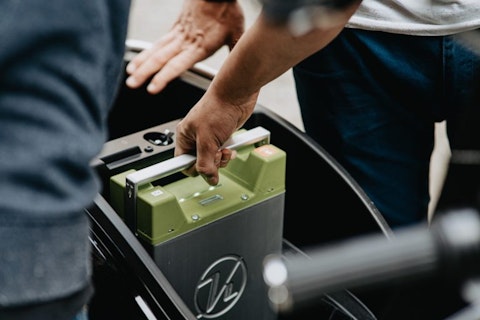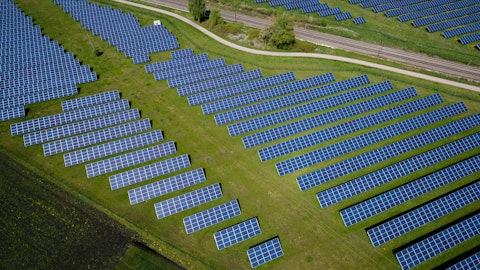In this article, we will be taking a look at the top 10 lithium mining companies in the world. To skip our detailed analysis, you can go directly to see the top 5 lithium mining companies in the world.
The importance of lithium has grown exponentially as the world has dramatically increased its focus on electric vehicles (EV) in the past decade, and in 2021, 540,000 metric tons of lithium were produced, with only a few countries and companies dominating the entire industry. Around 74% of total demand for lithium is for the manufacturing of rechargeable batteries for EVs, and is considered to be a critical component in many countries, especially in China and Western countries, as its availability impacts the transition to renewable energy.

Photo by Kumpan Electric on Unsplash
Outlook for the lithium industry
The lithium industry is expected to grow significantly within this decade as demand for EVs continue to grow, which is explained further in the countries with the most electric vehicles. While 10 million EVs were produced in 2020, and in Q1 2023, a 25% increase was witnessed quarter on quarter, which is why it should come as no surprise that lithium production is expected to grow by 5 times within the decade and reach 3 million metric tons in 2022. However, despite China being by far the biggest market in the world for EVs, accounting for nearly 60% of the total market, it is surprisingly still not the biggest lithium producer in the world. That accolade goes to Australia, where over half of the global supply of lithium is produced, which is why most of the biggest lithium mining companies in the world maintain operations in Australia, though Bolivia has the greatest lithium reserves in the world. However, the countries that produce the most lithium batteries by a distance are the U.S. and China.
Africa is expecting to become another major destination in terms of lithium production, with reserves discovered in several countries in the continent including Namibia, Ghana, Zimbabwe, DRC and Mali. This could also result in these countries becoming an attractive proposition for investors, and could help transform their fortunes, with many African countries being counted among the worst nations in the world to live in. This is especially relevant considering the fact that lithium demand has led to its price skyrocketing in the last couple of years. In fact, the price was 12 times higher in November 2022 as compared to 2021 and countries like Zimbabwe, which has been mining lithium for decades, have taken note of the potential fortune that the nation can earn, though prices have fallen since.
However, the issue for African nations is often the fact that often they don’t have the facilities, infrastructure and technology required to mine what they do have, and to find solutions to extract their reserves fully. After all, the International Trade Association believes that if Zimbabwe is able to fully extract resources already available, it could even meet up to 20% of the total global demand, and could become an in-demand country for lithium mining operations for the biggest global lithium companies.
Environmental cost of lithium extraction
Despite lithium being considered to be the raw material for a movement that is expected to benefit climate change exponentially, concerns are now being raised regarding lithium extraction costs, especially in countries where environmental regulations are lax. For example, in South America, lithium-rich deposits can be found in salt fields in Chile, Argentina and Bolivia, and while lithium extraction is expected to herald a cleaner future, the extraction itself is harmful to the environment. A Friends of the Earth report stated called out this impact stating it’s “increasingly affecting communities where this harmful extraction takes place, jeopardizing their access to water,” with water diversion impacting communities already affected by water scarcity.
Greater compliance with environmental regulations was also mentioned by one of the biggest lithium companies in Albemarle, which mentioned in its Q2 2023 earnings call ” Yes. I think, look, we have a lot of effort on R&D development, particularly around process chemistry and extraction around that. But I think the autoclave process is one of the ones we’re investigating, and I think the industry is looking at, but it’s down the road. So we’re focused on not only kind of near term, what we’re operating today, because we think there are significant productivity gains that we get out of our existing facilities as we’ve developed more sophisticated processes around that in the years to come. So the new plants we’re bringing up today, we see big productivity opportunities going forward for the next, well, 10 years probably, and probably beyond that as we get better and better at the process chemistry. It’s still early technology. It’s been operated for quite some time, but at scale, it’s still early technology. And then new technologies around that with different leaching agents and different techniques like pressure with an autoclave is something that we’re looking at, but it’s not something that’s going to be in scale production in the next year or two.”
Is lithium running out?
However, perhaps the biggest concern right now for the largest lithium producers in the world is the belief that lithium reserves may be running out, which is also having an impact on prices. The more pessimistic view expects that lithium reserves may even run out as soon as 2025, which would be devastating for the EV industry. On the other hand, many analysts believe that the reserves will last longer but still run out by 2030. BMI’s research indicates that lithium will run out by 2025 and China is likely to drive this shortage. We mentioned earlier that it’s the biggest market for EVs and BMI estimates that demand will rise by 20.4% year-on-year from 2023 to 2032, though its lithium product will only increase by 6% in the same timeframe, and hence, will be unable to satisfy even a third of total demand in the country.
Currently, there are just over 100 lithium mines globally, and though there are dozens of projects established to discover and explore new reserves, the process is incredibly time consuming and expensive, not to mention quite complex and hence, discoveries are unlikely to be able to fully satiate demand within time. The Vice President of Rystad Energy Susan Zou estimated that supply will jump by 30% to 40% year on year in 2023 and 2024, with the increased output resulting in shortages beginning from 2028. “In the next couple of years, though the lithium supply may stay adequate at a world-level, regional supply imbalance is still inevitable,” Zou said, adding “The global battery supply chain may find lithium in shortfall again approaching the end of this decade when the supply growth might not keep pace with that of the demand.”. The fact that the process of a fully operating lithium takes 10 years from the discovery of the mine does not bode well for lithium supply in the next several years either. This higher demand has been called out by Sociedad Química y Minera de Chile S.A. (NYSE:SQM) in its Q2 2023 earnings stating “We continue to see strong fundamentals behind lithium demand growth with the global EV sales showing another strong performance during the second quarter, increasing 50% year-over-year. We believe that the total EV sales growth could be close to 30% this year when compared to 2022. And the global lithium demand could increase at least 20% this year compared to the previous year.”
Methodology
To determine the biggest lithium mining companies in the world, we have ranked them based on their latest revenue, obtained from either Yahoo Finance or their own financial information, where available.
10. Lithium Americas Corp. (NYSE:LAC)
2023 Annual Revenue: $o
Lithium Americas Corp. (NYSE:LAC) runs operations in not just the U.S. but also in Argentina, where its project recently announced its first production. The company has gone into the divestment route and agreed a split into two different companies, which was approved by shareholders recently. Lithium Americas Corp. (NYSE:LAC) also recently received help from Ford Motor Company, which announced a $650 million investment to develop the Thacker Pass lithium mining project in Nevada.
9. Livent Corporation (NYSE:LTHM)
2023 Annual Revenue: $813 million
Livent Corporation (NYSE:LTHM) has announced a merger with Allkem to create a global lithium mining giant. The deal is expected to close by the end of this year and the resulting company will probably be among the top 5 lithium mining giants, with the new company expected to be valued at $10.6 billion.
8. Allkem
2023 Annual Revenue: $1.2 billion
Allkem recently entered into an agreement with Livent Corporation in a merger worth $10.6 billion and the new company is going to be much higher in our list of biggest lithium mining companies.
7. Sichuan Yahua Industrial Group Co. Ltd.
2023 Annual Revenue: $1.76 billion
Sichuan Yahua recently expanded a sales deal with Core Lithium from Australia, with the former being a major supplier of lithium batteries in China and also has part ownership in a lithium mine in Sichuan.
6. Mineral Resources Limited
2022 Annual Revenue: $3.4 billion
The largest Australian lithium mining company, Mineral Resources Limited recently entered into an agreement with Lithium Australia, to use the latter’s patented extraction method in order to derive a yield 50% above current industry averages, where Mineral Resources will provide up to A$4.5 million. The announcement resulted in Lithium Australia’s share price jumping by over 60%.
Please continue to see the top 5 Lithium Mining Companies in the World.
Suggested articles:
Disclosure: None. Top 10 lithium mining companies in the world is originally published at Insider Monkey.





